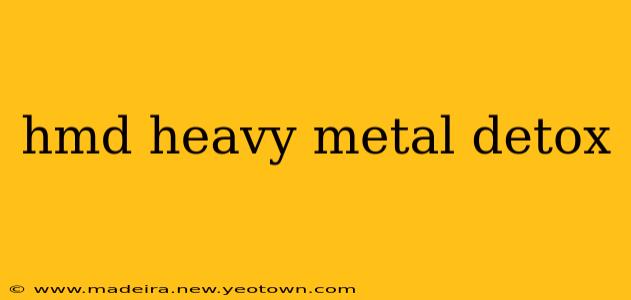Heavy metals. The very words conjure images of industrial pollution and toxic waste. But the reality is, even in seemingly pristine environments, we're exposed to trace amounts of these elements daily. This exposure, some believe, can accumulate over time and negatively impact our health, leading many to explore heavy metal detox methods like HMD (Heavy Metal Detox). But what exactly is HMD, and does it truly work? Let's unravel this complex topic.
Our journey into the world of HMD begins with a critical understanding: Heavy metal toxicity is a serious concern, but it's also a complex one, requiring careful consideration and a nuanced approach. While some individuals may genuinely benefit from interventions to reduce heavy metal burden, others may be chasing solutions for non-existent problems. This article aims to provide a balanced perspective, separating fact from fiction surrounding HMD and similar detox methods.
What is HMD (Heavy Metal Detox)?
HMD, or Heavy Metal Detox, isn't a single, standardized protocol. Instead, it encompasses a range of approaches aimed at eliminating or reducing heavy metal accumulation in the body. These methods often involve a combination of dietary changes, supplements, and sometimes, chelation therapy. The core principle is that by supporting the body's natural detoxification processes, or by providing targeted intervention, individuals can reduce their heavy metal load and potentially alleviate associated health issues. However, it's crucial to understand that this is often a process of supporting the body's inherent mechanisms, rather than a "quick fix" solution.
Does HMD Actually Work?
This is the million-dollar question. The efficacy of HMD varies drastically depending on several factors. The most important factor is the individual's actual heavy metal burden. If someone has no significant heavy metal toxicity, any detox intervention is likely unnecessary and potentially even harmful. Conversely, individuals with confirmed high levels of specific heavy metals (often identified through hair analysis or other testing—though the reliability of these tests remains a topic of debate) may benefit from interventions.
The type of intervention also matters significantly. Supplements and dietary changes might be helpful in supporting general detoxification processes, but chelation therapy requires strict medical supervision due to its potential side effects.
What are the Different Methods Used in HMD?
Several approaches are used within the umbrella of HMD:
- Dietary Changes: Emphasizing foods rich in antioxidants and those that bind to heavy metals (like cilantro, chlorella, and spirulina) can support natural detoxification pathways.
- Supplements: Many supplements are marketed to support heavy metal detoxification, including various chelating agents, antioxidants, and liver support formulas. However, their efficacy varies, and some lack rigorous scientific backing.
- Chelation Therapy: This medical procedure uses intravenous or oral chelating agents to bind to heavy metals and help their excretion from the body. Crucially, this should only be undertaken under strict medical supervision due to the potential for serious side effects.
What are the Potential Risks and Side Effects of HMD?
Any intervention, especially those aimed at manipulating the body's biochemistry, carries potential risks. HMD is no exception. Potential risks include:
- Nutrient Depletion: Some chelating agents can deplete essential minerals.
- Kidney Damage: Certain chelation agents can stress the kidneys.
- Interactions with Medications: HMD methods can interact negatively with certain medications.
- Misdiagnosis: Focusing on HMD without proper diagnosis may delay or hinder treatment for underlying health issues.
Who Should Consider HMD?
Individuals who suspect they have significant heavy metal toxicity due to occupational exposure, environmental factors, or other known sources may consider exploring HMD under the guidance of a qualified healthcare professional. This professional should perform appropriate testing to confirm the presence of toxicity before recommending any intervention.
What are the Signs of Heavy Metal Toxicity?
Symptoms of heavy metal toxicity can be non-specific and mimic many other health conditions. Some commonly reported symptoms include fatigue, headache, digestive problems, neurological issues, and skin rashes. It's crucial to remember that these symptoms alone do not confirm heavy metal toxicity and require proper medical evaluation.
How Can I Detox from Heavy Metals Naturally?
Natural approaches focus on supporting the body's inherent detoxification mechanisms. This involves a healthy diet rich in fruits, vegetables, and whole grains, adequate hydration, regular exercise, and stress management techniques. These lifestyle changes promote overall well-being and support the liver and kidneys, the primary organs involved in detoxification.
Conclusion: Proceed with Caution
HMD, while potentially beneficial in certain circumstances, isn't a miracle cure-all. It's a complex area requiring careful consideration and guidance from qualified healthcare professionals. Self-treating based on unsubstantiated claims can be risky. Prioritizing a healthy lifestyle, getting regular check-ups, and seeking professional advice when concerned about heavy metal exposure are far more crucial steps than relying on unproven detox methods. Always consult with a doctor before starting any heavy metal detox program.

